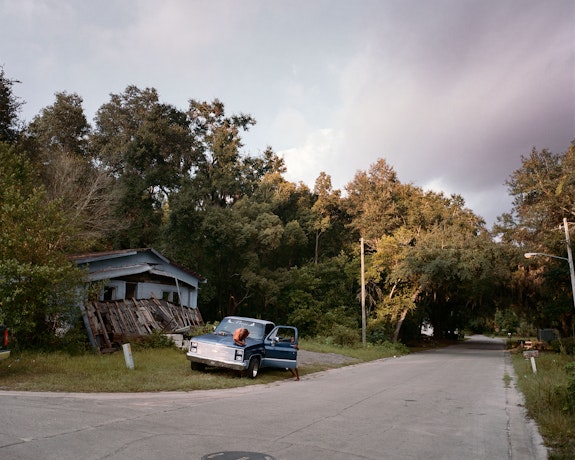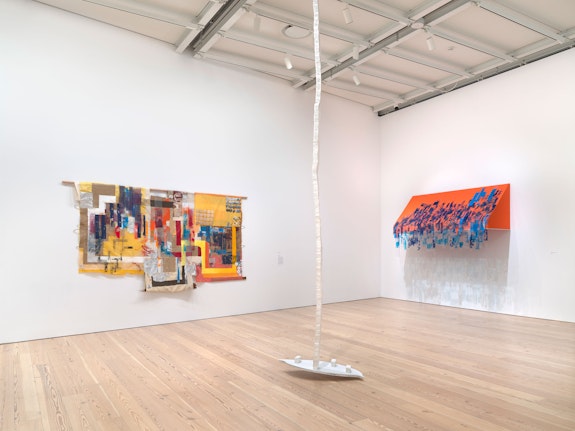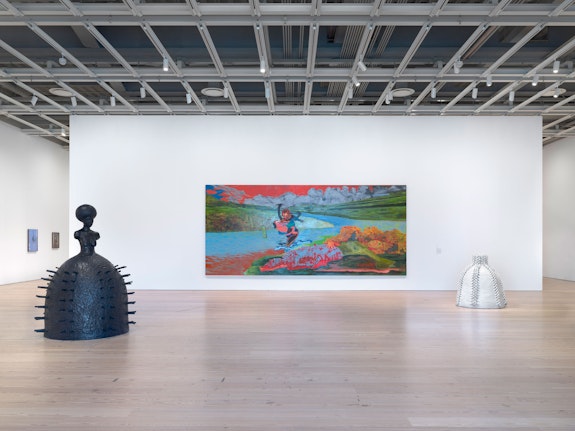ArtSeen
2019 Whitney Biennial
Curators Rujeko Hockley and Jane Panetta describe the 2019 Whitney Biennial as a “snapshot” of art making in the United States today. But “snapshot” carries particular meaning: not a posed portrait but something informal. Snapshots are often imperfect, but the 2019 Biennial reads like an unexpected, tender one, encouraging intimacy, identification and empathy. That is, the 57 artists in the galleries and 18 represented in performance and film don’t crowd their work with pointed critiques of racism, sexism, misogyny, and colonialism, but instead invite viewers into their respective worlds and identities.
On View
Whitney Museum of American ArtMay 17 – September 22, 2019
Scattered between rows of pilasters and cornices in Milano Chow’s layered graphite drawings are a few curious details: zig-zagging stairs to nowhere, porcelain vases and imposing Chinese guardian lions. Together they ornament a theatrical advent calendar of sorts, wherein chic but secretive, androgynous women dressed in qipaos and suits pass between windows. Chow’s drawings are set in British Hong Kong, and her characters expressed repressed longing for the familiar in their newly imperialized home. That same poignant yearning comes across in Curran Hatleberg’s photographs. In Untitled (Water’s Edge) (2019), orange daisies dip from the weight of their own blooming as a camouflaged crocodile lurks by and in Untitled (Blue Truck) (2016), a black boy squats curled up on the hood of a car as a pink sunset hangs faintly in the air.
Ellie Ga’s filmic essays of refugees are stories told through puzzles, as her narration guides us over slides on a lightbox. The bottles of unread messages and piles of abandoned life vests (one with a drawing by a 12-year-old Syrian boy) are reflected in the kaleidoscopic trash heap of photos Ga uses as sources. Carolyn Lazard’s Extended Stay (2019), set on a medical arm mount, displays a small monitor receiving live public access TV scrubs of debates on free speech and talk show guests in wheelchairs demanding infrastructure that is accessible to the differently abled.
For a change in pace, Meriem Bennani’s video installation on the fifth floor terrace dips into absurdism to disarm viewers before showing them the remnants of an inculcated colonialism among Moroccan prep school teens. Playing a talking cartoon donkey, Bennani trots across the screen and converses with students in French as they party, uses Snapchat and discusses moments of Anti-Arabism they encountered growing up. In one scene, a young girl recounts with a mix of fear and embarrassment how her family was stopped by guards at the Eiffel Tower. Everything plays under Googie-style shacks, and another video features a choir of schlocky luxury homes, their facades plastered with grinning faces. A looming Starburst sky sets the scene for Janiva Ellis’s expansive painting Uh Oh, Look Who Got Wet (2019), wherein a river rescue is thwarted by a leering, frog-eyed creature peeling the central figure’s face off from within. Ellis’s brushwork, especially evident in the splashes and overgrown flora, is electric and ominous. Using humor, Ilana Harris-Babou plays a self-consciously naïve luxury furniture dealer in her video Human Design (2019), finding her roots in Africa—exposing how companies like Restoration Hardware glom together cultural motifs to resell them in designer goods.
As is to be expected, the Biennial is not perfect. The downside of quiet, intimate art is that it can feel overwrought or simplistic. Kota Ezawa’s watercolor video of NFL players kneeling during the national anthem dilutes the politics for aesthetic effect, and Josh Kline’s shadow boxes of government buildings flooding from climate change are glib in their punchy literalness. Caroline Monnet’s video Mobilize (2015) was originally commissioned for the 2015 Aboriginal Pavilion, and its motivational sports ad pacing feels out of place. And Forensic Architecture, whose work was perhaps most anticipated for its response to the call for Warren B. Kanders, CEO of the tear gas company Safariland and vice chair of the Whitney’s board to step down, was also a disappointment. Set to the background music of Richard Strauss’s Last Four Songs, taken from a concert in Aspen which Kanders funded, Triple Chaser (2019) is didactic. It explains how the group created a computer program to scan photos and clips to prove the use of the Triple Chaser grenade, outlawed by most governments in wartime, as a tool for social control in the West Bank, Ferguson, Mo., at the Mexico-United States border, and many other far-flung countries. The video ends discussing Sierra Bullets, the most recent addition to Kanders’ portfolio. The problem with the video is it tells us things we already know⎯Sanders funds war crimes. It comes off as an artwork which is included to placate Whitney protestors, treating them like children throwing a tantrum to get Kanders out, while knowing the Museum will never budge.
One of the most effective works in the show is Tomashi Jackson’s Third Party Transfer and the Making of Central Park (Seneca Village – Brooklyn 1853-2019) (2019), which foregrounds color in strips of bright blue plastic that run over a lava orange store awning. Together the transparent plastic strips form and project onto the wall a jigsaw history of Seneca Village, the first black-owned settlement in New York razed in 1857 to build Central Park. Looking underneath the awning, we see archival photographs of protesting black women which are pierced by the tacks that hold them in place. On Hometown Buffet-Two Blues (Limited Value Exercise) (2019) and The Woman is King (Mary and Marlene) (Simultaneous Contrast) (2019), Jackson’s attached pins with headlines detailing the de Blasio administration’s abuse of the Third Party Transfer Program in 2018 to seize property from black and brown families in Brooklyn. In a similar way, Troy Michie collages scraps from the Vogue Pattern Service and pornography magazines to “clothe” nude black models. Los Atravesados / The Skin of the Earth is Seamless (2019), floats a torn T-shirt neckline as a shoddy halo above a photo of scribbled over men. The found photographs that Jackson and Michie source, as well as Jennifer Packer’s rendering of a loved one’s polaroid as a smudge in the background of an effaced yellow painting, reflect the fact that some of the best work in the Biennial references photography, perhaps due to its ability to capture intimacy.
By collaborating with 10 artists in a series of mirror self-portraits that sometimes picture the camera reflected back, Paul Mpagi Sepuya reveals the at times coy relationship that unfolds between photographer and subject. Giancarlo Montes Santangelo is almost peering over Sepuya’s shoulder in a photograph of his camera’s LED display—provoking the question: what are they both seeing? Or one wonders who snapped first in Dicko Chan and Sepuya’s self-portrait where they grasp both each other and the camera in a helix embrace. In Elle Pérez’s t (2019), the names of printed hormones blur and dissolve in a viscous liquid, swished around in a glass vial between someone’s soft, glowing fingers. And in Mae (three days after) (2019) we see the thin scalp scar and bruised, half-lilting eyelid of a trans woman after transitioning. Intimacy can be strong, Pérez suggests.
One gap—I wish performance was more integrated into the Biennial. Performance is harder to find online, but based on previous work, nibia pastrana santiago, Madeline Hollander and Las Nietas de Nonó promise to have incisive, site-responsive work. I highly recommend looking into these artists, and visiting the Biennial on a film or performance weekend to get a full picture of the exhibition.





